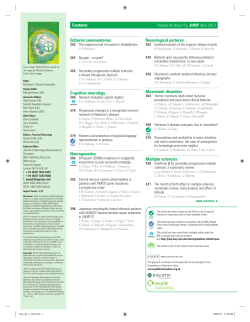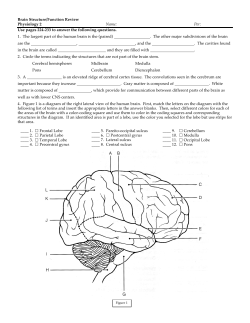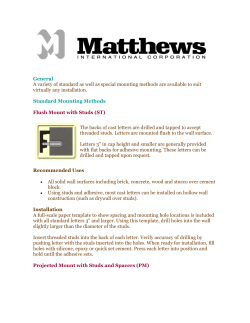
Document 56770
Downloaded from adc.bmj.com on August 22, 2014 - Published by group.bmj.com
606 Archives of Disease in Childhood, 1986, 61
References
Kidd BSL. Congenital heart disease (malformations usually
productive of cyanosis). In: Forfar JO, Arneil GC, eds.
Textbook of paediatrics, Vol 1. Edinburgh: Churchill Livingstone, 1984: 641-2.
2 Shinebourne EA, Anderson RH. Current paediatric cardiology,
Oxford: Oxford University Press, 1980:36.
3 Warburton D, Rehan M, Shineboume EA. Selective criteria for
differential diagnosis of infants with symptoms of congenital
heart disease. Arch Dis Child 1981;56:94-100.
4 Shinebourne EA, Del Torso S, Miller GAH, Jones ODH,
Capuani A, Lincoln C. Total anomalous pulmonary venous
drainage, medical aspects and surgical indications. In: Parenzan L, Crupi G, Graham G, eds. Congenital heart surgery in the
first 3 months of life, medical and surgical aspects. Bologna:
Patron Editore, 1981:447-59.
5 Rudolph AM. Congenital diseases of the heart. Chicago:
Yearbook Medical Publishers, 1974:586-95.
Correspondence to Dr R McKay, Royal Liverpool Children's
Hospital, Myrtle Street, Liverpool L7 7DG.
Received 4 February 1986
Commentary
J F N TAYLOR
Thoracic Unit, Hospital for Sick Children,
London
The hyperoxia or nitrogen washout test is used to
differentiate pulmonary disease from cardiac disease
in the cyanotic neonate. A timely reminder that a
major rise in systemic arterial oxygen tension
(> 150 mmHg) does not always exclude the
presence of a basically cyanotic lesion is given
above, and the lesion described is not the sole lesion
responsible for this response in the first few days of
life.
A more common failure of differentiation occurs
in the presence of pulmonary disease associated with
a cardiac lesion. In the very young neonate increasing the ambient oxygen concentration does not
invariably overcome pulmonary venous desaturation, so that clinically inapparent lung disease may
limit the rise in systemic arterial saturation, and an
apparently minor chest radiological abnormality can
be associated with so profound a change in pulmonary circulatory physiology that there is no rise in
systemic arterial saturation under the conditions of
the test.
The result of the test may only be appropriately
interpreted if the arterial samples are taken from the
right arm (assuming situs solitus), the carbon
dioxide tension is normal, and the infant exhibits no
clinical features of respiratory distress. The chest
radiograph should be carefully scrutinised for any
pulmonary abnormalities. Remember a change in
ductal calibre may lead to a different result on
repeat testing. Cross sectional echocardiography is
an essential examination in the differentiation of
pulmonary from cardiac disease and in delineating
the nature of any cardiac lesion in the neonatal
period. In experienced hands it is the more reliable
examination.
Vanishing earrings
C DE SAN LAZARO AND R H JACKSON
The Children's Day Unit, Royal Victoria Infirmary, Newcastle upon Tyne
Case histories
SUMMARY Four children who presented with impacted earrings are described. We suggest that the
insertion of earrings in children under 10 years has
hazards and recommend the use of sterling silver or
9 ct gold if the procedure is to be done in young
children.
Parents are under increased pressure to accede to
requests for ear piercing from very young offspring.
As paediatricians we are sometimes asked to arbitrate in these matters when children are known to
us. We have recently seen four children where ear
piercing resulted in impaction.
Case 1. A child of 8 years who was known to have
asthma and mild eczema had her earlobes pierced
with a paediatrician's blessing six weeks before
presenting to the hospital. Sterling silver earrings
were used. Three weeks after the procedure she
demanded and was permitted a pair of gold plated
ornamental studs. Within a week the right earlobe
became itchy and crusty. The condition resolved
after removal of the studs. A few days before she
presented, however, she had replaced the studs. The
right earlobe became mildly itchy again, and one
morning the lobe was found to be extremely swollen
and painful. The earring could not be located and
was thought to have fallen out.
Downloaded from adc.bmj.com on August 22, 2014 - Published by group.bmj.com
Vanishing earrings 607
On examination the child was well but in considerable pain. The earring could not be seen in the
swollen, macerated earlobe. Pus extruded from the
posterior aspect of the lobe. A radiograph showed
the presence of the entire earring in the soft tissues.
(Figure).
Under general anaesthetic the lobe was explored
and the earring removed. Antibiotics were prescribed and the swelling disappeared gradually over
a few days. There was a small scar a few weeks later.
Case 2. A girl of 5 years who was known to have
cyclical neutropenia presented to the department
two weeks after the insertion of studs in both ears.
Overnight the right earlobe had become grossly
painful and swollen. The earring on that side could
not be seen and was thought to have fallen out.
Findings were similar to those described in case 1.
Palpation of the lobe was exquisitely painful, and a
radiograph was obtained. This again confirmed the
presence of the stud in the soft tissues. The lobe was
infiltrated with a local anaesthetic, and after a small
incision the stud was removed with great difficulty
because of the size of the retaining clip. A small
amount of pus extruded from the wound. The lobe
healed over in a few days, leaving a tiny nodular
scar.
Cases 3 and 4. These were two girls of 6 and 8 years,
respectively. Neither had predisposing illnesses and
both were in good health. Both had had earrings
inserted within two weeks of presenting and in both
one earring had become impacted. In one this
occurred on the right side, but in the six year old the
/
.,
-.
Figure Radiograph of ear of case I showing complete
earring 'invisible' at examination of ear.
left side was involved; this child was a right thumb
sucker. Progress in both children was as described in
case 1.
Discussion
The four children described were all under 10 years
of age. Each stud removed consisted of a tapered
pin with an ornamental head of variable size up to 4
mm across. The pin passed through the lobe and was
kept in place with a winged clip ('butterfly clip'),
which locked into a grooved position on the pin.
We visited several high street stores to examine
standards of procedure. In a large store providing a
walk in service we observed 11 children in the space
of an hour who had earrings inserted. Four of these
children were aged under 5. The service charge was
80 pence for each stud inserted. The studs were of a
bright gold colour and carried a small stone. No
advice regarding antisepsis was offered. A small
plastic spray tube containing 20 ml of a solution of
chlorhexidine and spirit was available. Its price
more than doubled the cost of the exercise, and only
one purchase was made.
At a second store the cost of ear piercing was
much higher. Children under the age of 10
were not accepted for the procedure. The practice
was to use either sterling silver or 9 ct gold studs.
This practice was based on long experience of
younger children presenting with problems after ear
piercing. We believe that the use of studs dipped in
gold paint in very young children results in the
flaking off of minute particles of paint when the
studs are tampered with-a temptation unlikely to
be resisted by the very young child. The use of nonplated, non-allergenic material is likely to prevent
the kind of reaction and subsequent infection seen in
our four cases.
The problem of impacted earrings is not uncommonly seen in accident and emergency departments.1 Trends in present fashion suggest that
more young children are likely to present with
problems. Although we have seen no serious sequelae, the experience for children we have seen has
been frightening and memorable. Parents should be
asked to resist firmly the demands of their very
young children. When earrings are selected they
should be of non-allergenic material, and regular
application of an antiseptic to the site should be
encouraged.
Reference
' Jay AL. Ear-piercing problems. Br Med J 1977;ii:574-5.
Correspondence to Dr C de San Lazaro, The Children's Day Unit,
Royal Victoria Infirmary, Newcastle upon Tyne NEI 4LP,
England.
Received 3 February 1986
Downloaded from adc.bmj.com on August 22, 2014 - Published by group.bmj.com
Vanishing earrings.
C de San Lazaro and R H Jackson
Arch Dis Child 1986 61: 606-607
doi: 10.1136/adc.61.6.606-a
Updated information and services can be found at:
http://adc.bmj.com/content/61/6/606.1
These include:
Email alerting
service
Receive free email alerts when new articles cite this
article. Sign up in the box at the top right corner of
the online article.
Notes
To request permissions go to:
http://group.bmj.com/group/rights-licensing/permissions
To order reprints go to:
http://journals.bmj.com/cgi/reprintform
To subscribe to BMJ go to:
http://group.bmj.com/subscribe/
© Copyright 2025





















